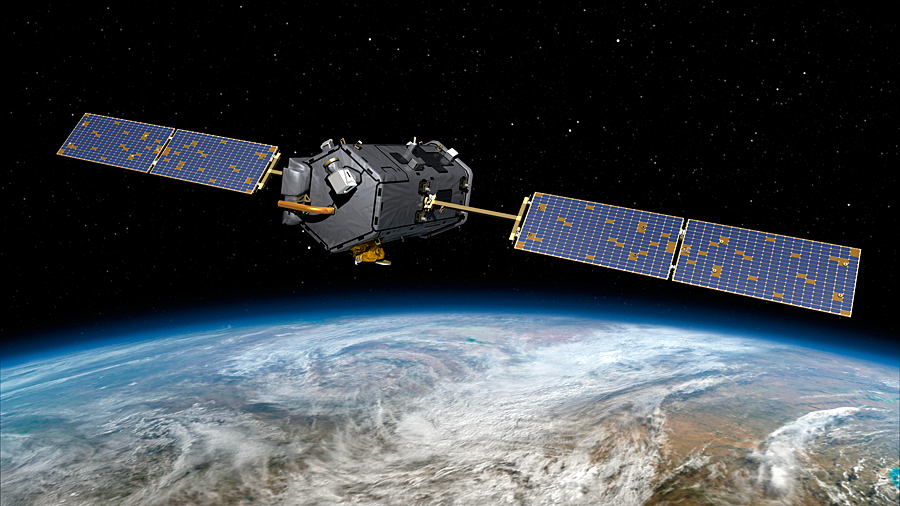NASA satellite could answer nagging global warming questions
Loading...
The National Aeronautics and Space Administration is making final preparations for a Tuesday morning launch of a $468 million mission to take the measure of Earth's carbon cycle.
The Orbiting Carbon Observatory, Version 2.0 (OCO-2), is designed to monitor changes to carbon dioxide levels in the atmosphere in enough detail to allow researchers to address nagging questions about how the cycle works and where its hot spots are.
That cycle, with its sources and "sinks" for exchanging CO2 with the atmosphere, lies at the heart of the impact that human use of fossil fuels has in warming global climate as well as on marine chemistry through ocean acidification.
The sinks are of particular interest, suggests David Crisp, the mission's science-team leader at NASA's Jet Propulsion Laboratory (JPL) in Pasadena, Calif.
"It's absolutely critical that we learn what processes are absorbing carbon dioxide in our system today – over half the carbon dioxide we're emitting," Dr. Crisp said during a prelaunch briefing on Sunday. "We need to understand, first of all, how much longer they might continue to do us that great favor."
With its global coverage and exquisite sensitivity, the satellite is expected to provide "a rich bunch of data we've never had," adds Richard Houghton, a senior scientist and acting president of the Woods Hole Research Center in Falmouth, Mass. Dr. Houghton's research focuses on land-based components of the carbon cycle.
The orbiter is what mission officials call a carbon copy (pun intended) of the original Orbiting Carbon Observatory, which was launched Feb. 24, 2009, but failed to reach orbit.
Now, the satellite is perched atop a Delta II rocket at Vandenberg Air Force Base, on the California coast about 56 miles northwest of Santa Barbara. Liftoff is scheduled for 5:56 a.m. EDT Tuesday.
The 1,000-pound spacecraft carries only one instrument: an array of three near-infrared spectrometers that measure the relative abundances of CO2 and oxygen in the atmosphere, with each spectrometer looking at different wavelengths of near-IR radiation. The spectrometers are designed to detect as few as one molecule of CO2 for every million molecules of other gases in the atmosphere. Current concentrations of CO2 atmosphere-wide are flirting with 400 parts per million, the highest level in at least 800,000 years.
The craft will take up position at the head of a constellation of five other environmental spacecraft known as the A-Train – closely spaced satellites on an orbit over the poles that keeps them in perpetual afternoon sunlight. When passing over land, OCO-2's spectrometers will look straight down and use the light reflected off Earth to reveal the chemical fingerprints of CO2 in the atmosphere. When passing over oceans, the reflected disk of the sun off the water will serve as the light source.
With each 99-minute orbit, the craft will gather as many as 69,000 measurements, significantly expanding the number of CO2 measurements that researchers take each day.
The craft's path will periodically take it over the US Department of Energy's Atmospheric Radiation Measurement site near Lamont, Okla., an overflight that will allow researchers to use ground-based CO2 measurements to ensure the satellite measurements are accurate.
One key mystery that OCO-2 could help solve is what has been called the missing "sink" for CO2, or as it's known these days, the residual terrestrial sink, Houghton says.
"We know it has to exist," he says. "We just don't know where it is."
Only about half of fossil-fuel emissions remain in the atmosphere. Of the emissions that don't make it, about half are taken up by the oceans. The other half must be taken up by land-based processes, he continues.
But land uptake is harder to gauge because the CO2 isn't as well mixed across the landscape as it is throughout the fluid atmosphere or oceans. Different patches of land can soak up or release CO2 at different rates based on, among other things, vegetation and climate.
Researchers have their favorite ideas for the missing sink. Some point to tropical rain forests, others point to mid-latitude forests, while still others point to boreal forests in Canada or Siberia.
Each group musters good theoretical arguments to support its position, and about once a year, a team publishes results that prove it's one of those three – "but it's different every year," Crisp of JPL said.
Quite apart from nailing down global-scale sinks and sources, "it's possible that a satellite like this will help us resolve the carbon consequences of large-scale disturbances like regional or continental drought or very large fires," says Robert Jackson, a Stanford professor who studies the global carbon cycle.
Over the long term, future satellites like OCO-2 could play a role verifying compliance with global climate treaties, although that's more likely at a broad, regional scale rather than on a smokestack-by-smokestack basis.
For now, mission managers and scientists associated with the mission will be happy just to see OCO-2 safely on orbit beaming back data. It will take six to seven weeks to check out the craft's systems on orbit and ensure the spectrometers are working as they should, mission officials say.
Some 10-1/2 years and one failure in the making, OCO-2 represents a comeback for the mission's scientists, as well as those who planned on using the data. Dr. Jackson was cochairing a panel charting a 10-year plan for carbon-cycle research, a process about two-thirds complete when the original OCO failed to reach orbit. It was to have played a key role in the plan, Jackson says.
With Tuesday's launch, "it's absolutely fantastic to get another opportunity to conduct these incredibly important scientific measurements," Crisp said. "It's been a long, hard road, but boy, I'm glad to be back."








